How to Write a Social Media Policy? With free templates
A Social Media Policy is an essential tool for any business that has something to do with social media.
In fact, even if your company doesn’t use social media, having a social media policy is still of great importance. Why? Because your employees almost definitely do: 72% of Americans use at least one social media platform. However, 63% of Americans say their boss has no social media code of conduct.
A Social Media Policy is not merely a series of guidelines or rules. It supports, advises, and motivates your employees in the worst or best cases.
Not sure where to begin? Continue to read. This article will go through the definition of social media policy, its structure, and how to write one with free templates.
What is a social media policy.
Having a social media policy is vital in ensuring your staff understand what they can or can not do on social media. Plus, social media policy will help to reduce any legal or security problems for your business.
Simply put, social media policy reduces the uncertainty of posting something on social media. One of the biggest reasons for low active marketing on social media among employees is deeply embedded in fear of social media. They fear that their business or career might be on the line if they say something wrong or share it in the wrong way. The opposite is also true: companies fear their employees will create a communication crisis or negative reputation; worse, they could violate the law of social media conformity.

This is where social media policy kicks in. A social media policy specifies how a company and its members should conduct themselves online.
Not only that, a good, up-to-date social media policy mitigates risk and sets the team up for success, presenting them with guidelines about how and when to share content, etiquette to obey, sharing rewards, and tips for making interactive posts.
The problem is that many firms do not know how best to organize a strong social policy and ensure that their workers read it.
You can solve the problem by making your social media policy easy-to-read, straightforward, accessible, and constantly get updated. The aim is not to infuriate your workers or inhibit social media engagement by employees. With that being said, it does need to make clear of some basic conduct, so there are no significant problems in the future.
Key Takeaway: A social media policy specifies how a company and its members should conduct themselves online. It helps preserve your company’s online reputation and allows workers to share the company on their online networks.
The structure of a social media policy.
Introduction.
Social networking is a massive online network where consumers, partners, vendors, and shareholders come together to share data, advertise goods and services, and express feelings and opinions. [Company Name] understands the complexities and dangers of social media and how it can influence our company’s reputation, public image, and core beliefs. Therefore, we have formed this social media policy to lay out a blueprint of tested social media guidelines and standards.
Objective.
The aim of this social media policy is to: (a) clarify the company’s social media guidelines and standards (b) describe the rules related to the use of both business and individual social media (c) clarify the corrective action system of the company for rule violations.
Scope.
This social media policy extends to all [company name] members, including interns, volunteers, contractors, temporary, part-time, and full-time employees. [Company Name] identifies social media as any type of digital communication or application that allows users to generate and exchange information, views, media, and personal and public messages in a digital setting.
Corporate Use.
Employees responsible for promoting the company on social media are obliged to preserve the its image, core beliefs, and brand. [company name] requires all workers to be fair, professional, and respectful to all members, partners, customers, clients, and/or suppliers of [company name].
Personal Use.
[Company name] encourages its workers to use personal social media networks at work for at least [number of hours] a day to ensure maximum efficiency. However, we ask our workers to be accountable for their time and always ensure that commitments and obligations for work are met on time.
While [company name] agrees that we do not discourage our staff from publishing personal views and material on private accounts, we require our team to demonstrate the highest amount of respect and conform to the anti-discriminatory and harassment policies of our company.
Social Media Guidelines.
As a member and representative of [company name], you are required to show appropriate etiquette on social media, including but not limited to the following:
- Avoid discussing and/or posting about topics outside of the company’s area.
- Respond timely to all inquiries.
- Correct or remove content that is inaccurate and/or misleading.
- Adhere to the privacy contract and anti-discriminatory policies of the company.
- Must not publish derogatory, racist, abusive, offensive, and misleading information or sharing it.
- [as many guidelines as is necessary]
Customer Inquiries
[Describe the procedure workers are expected to obey when they are contacted via social media by a customer and client.]
Controversial content
[Describe the procedure that workers are supposed to follow regarding to rumors, news leaks, private documents, or other dubious social media material about the company.]
Marketing campaigns.
- The Social Media Manager and Publicity Manager are expected to make an official [weekly/monthly/quarterly] social media timeline.
- The social media timeline must be approved by [whom] [number of days] before the start of a period
- The Social Media Manager and Publicity Manager must carefully check the material for any misleading or false facts when the organization is about to reveal big announcements or launch promotions on social media.
Tactical guidelines.
When do I need permission to post content on social media?
[insert reply, including who to ask for permission]
What kind of information am I permitted to post on social media about my work?
[insert reply and examples]
Do I need to have information about my business in my bio on social media? Or do I hold separate accounts for my business and my personal accounts?
[insert reply and examples]
During a PR crisis, what do I do on social media?
[insert reply and examples]
How can I comply with social media copyright law?
[insert reply and examples]
Consequence of Breach
[Explicitly define the discipline process for members failing to comply with the social media policy]
If an employee [company name] does not meet the rules laid out in this policy on social media, management of [company name] will have rights to implement administrative action, including reprimand, written warning, and/or termination. Breaches of the regulation include:
- Overlooking career responsibilities and schedules attributable to inappropriate usage of the office of social media.
- Publishing company confidential information on both personal and corporate social media platforms.
- Posting inappropriate content and subject matter on social media.
- Posting insulting comments and failing to address customers’ concerns.
- Posting misleading facts, false information, and/or personal views on corporate social media platforms.
Each offense or policy breach will be carefully examined by the Executive Marketing Manager and HR representative until a disciplinary action is made official.
Review
This policy will be reviewed [once per month/quarter/year]. All employees will be provided with a [digital/physical] copy.
Why is Social Media Policy important?
Maybe you’ve already bypassed social media issues. Or maybe your social media strategy has been performing brilliantly. Either way, why should you go through the trouble of developing, revising, and launching the organization’s Social Media Policy?
There are a few convincing explanations. Social Media Policy can help you to:
- Maintain the brand reputation and brand identity across multiple platforms
- Treat legal and regulatory sensitivities attentively.
- Prevent a breach of confidentiality
- Prevent a full-blown crisis in PR
- Act immediately if a crisis or violation happens.
- Be upfront with your staff about social media obligations
- Encourage your workers to understand and spread the values of your company.
How to write a good social media policy?
We have a few tips for you to write your Social Media Policy
1. Use our Social Media Policy template.
Check out: The structure of a social media policy It’s free, and all the questions you need to get started are answered.
2. Define your staff’s positions
Who manages which social accounts? Who is responsible for which tasks on a weekly, monthly or another basis? It might be advantageous to include personal details so that staff members from other teams know who to notify.
Obligations might include:
- Approvals
- PR Crisis addressing
- Regular service to consumers
- Strategy and preparation
- Social media training for other employees
- Daily uploading and engagement
- Publicity
- Passwords and authentication
- Listening and Monitoring
- Who can represent the brand and who cannot.

3. Create security protocols.
How often do you change your account passwords? Who is held responsible for maintaining them, and who has access to your accounts? Where can people access your accounts? Who should employees come to if they want to issue a concern?
4. Make a plan for your PR crisis.
Your social media policy’s purpose is to eliminate the need for a crisis PR strategy
However, it’s better to have both: Social Media Policy and a PR crisis plan.
Your crisis handling plan should have an up-to-date emergency contact list with a special ability to help you. It can be all the way up to the senior executives, the social media unit, regulatory and PR experts.
You should also have guidelines for identifying the nature of the crisis, an internal negotiation strategy, and an approval process that would help you deal with the situation.
5. Outline how to comply with the law.
Details can differ from state to state, or region to region, so contact the legal counsel. Outline how to be consistent with the legislation. Your policy should be touching on the followings:
- Copyright: Intellectual property is no joke, so it’s best to clarify how to comply with social media copyright law, mainly when using content from third parties.
- Confidentiality: Do all the staff know how to manage customer information? Confidentiality refers to upholding the internal knowledge of the organization. Whether or not you make the individuals sign non-disclosure documents, they should be mindful of the repercussions of sharing social media details that the company deems private.

6. Provide guidelines for how employers behave on their private social media accounts.
According to pewresearch.org, only one-third of Americans says that their company has a policy about how employees should behave themselves online.
Posting hate speech on social media, threats, aggression, intimidation, or racist slurs should be the acts that violate the law, or the code of ethics of the organization, or both. Nonetheless, your people should know that they will be held accountable for how they behave online. When writing a social media policy, it’s important to consider the use of a virtual data room VDR provider to ensure that sensitive company information is securely stored and accessed only by authorized personnel.
7. Embolden everyone on board to participate in writing a social media policy.
Your organization’s system administrators, HR team, and public spokespeople possibly have some essential ideas that will help polish up your social media policy. Of course, the most important discussion will be with the legal staff.
Don’t get wrapped up in instructions or specifics when you draft your policy. Inevitably, the nitty-gritty parts will change, even before you know it. You’d better concentrate on the big picture.
8. Decide where to put your policy.
We strongly recommend inserting your policy into your employment contract or employee handbook so that during onboarding, new employees can read (and enjoy!) it.
But where can existing staff access it? There are multiple ways. It can be an internal network of your business or on shared drives. You can also put it on your external website based on the needs of your organization.

9. Launch it (or relaunch it)
You’ll want to make sure everyone is conscious that a Social Media Policy will follow, whether it’s a rewrite or a brand-new policy. Remember to leave with plenty of space and time for questions, whether you publish it via the best intranet platform or at an all-hands meeting.
10. Review
Engaging in an annual or bi-annual review will ensure that the strategy remains essential and applicable.
And don’t forget to mention the date of a revision somewhere within the paper as you make changes.
8 Social media policy examples to learn
Don’t know what to do? Try examining these brilliant Social Media Policy examples. People were in your shoes, and some of them have come up with exceptionally brilliant ideas. So why don’t you learn from them?
1. Adidas Group Social Media Guidelines.
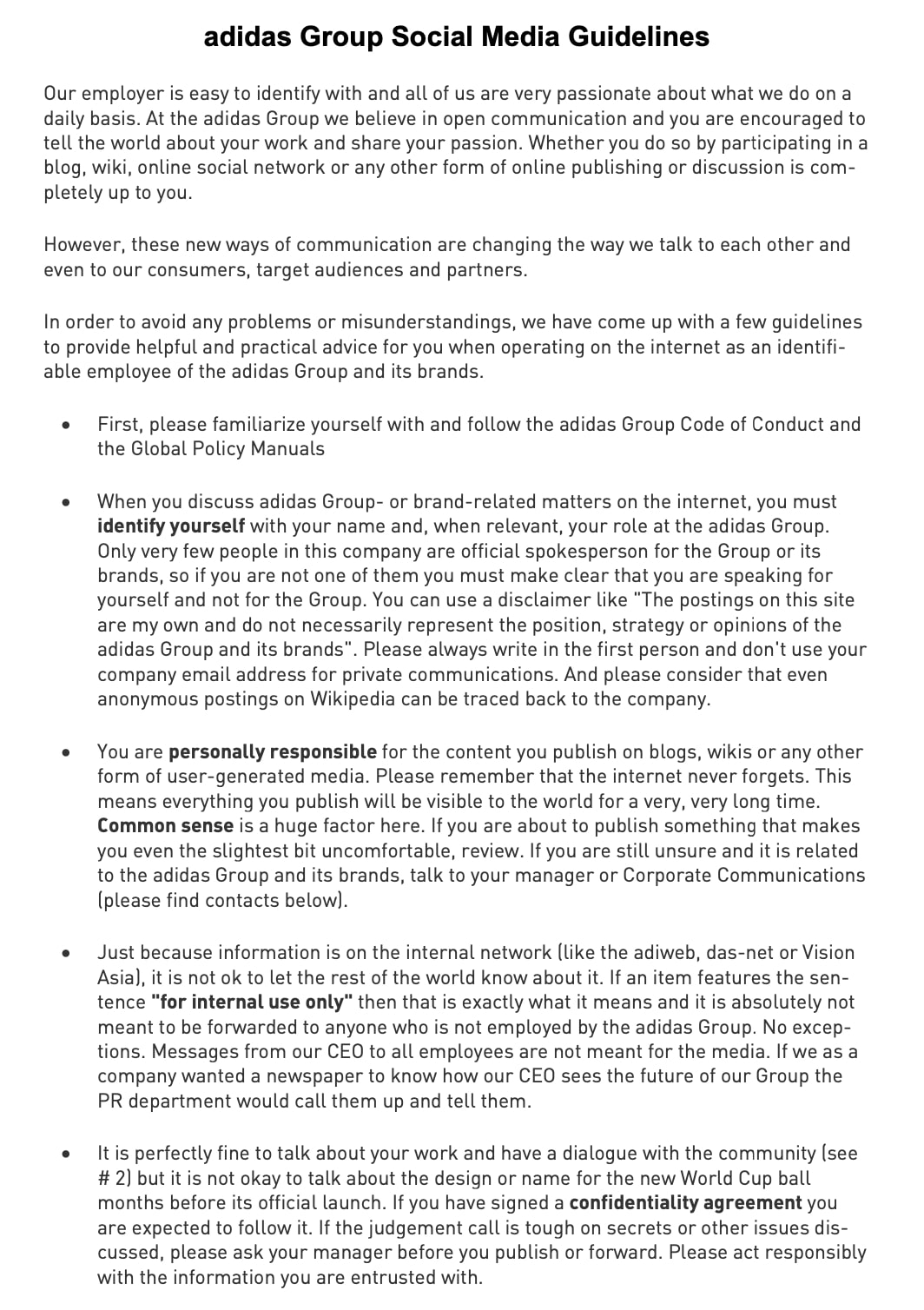
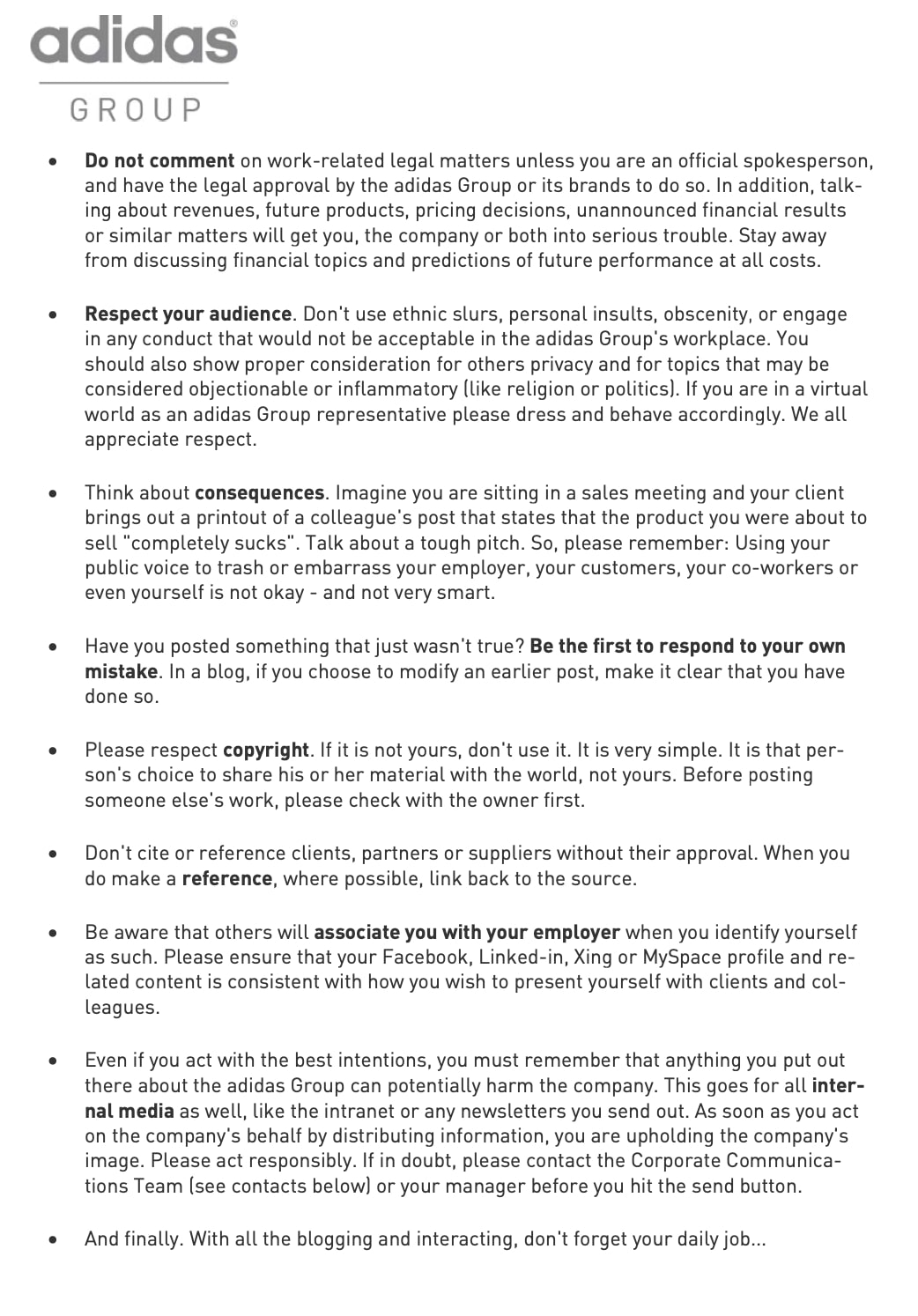
Adidas’ social media policy is neat, straightforward, and less preachy than other policies.
Adidas’ policies are full of common sense and human-speak, as opposed to full of “ambiguous terms.” You can see Adidas makes it a point to use informal languages, such as “please”; “okay.” This policy is straight to the point.
Good points.
-
Informative, inspiring opening sentence: “At the Adidas Group, we believe in open communication, and you are encouraged to tell the world about your work and share your passion.” The company gravitates towards the fact that their employees are already active on social media and motivates them to talk about their working life at Adidas.
-
Gently remind their employees that they’re held accountable for the content they put out and that they should be upfront about their mistakes. “You are personally responsible for the content you publish on blogs, wikis, or any other form of user-generated media. Please remember that the Internet never forgets.” “Be the first to respond to your own mistake.”
-
Provides examples “In a blog, if you choose to modify an earlier post, make it clear that you have done so” “even anonymous postings on Wikipedia can be traced back to the company.”
-
Adidas does not prohibit the use of Social Media at work. Yet they still gently remind their employees, “*With all the blogging and interacting, don’t forget your daily job… *”
Not-so-good points.
- There is no guideline for managing particular cases such as consumer concerns and PR disasters.
- There is no guidance on which team to contact.
2. Coca-Cola Social Media Policy.
Coca-Cola Social Media Policy is one of the longer and text denser policies among the eight examples.
Good Points.
-
Coca-Cola’s social media policy champions employee engagement online from the beginning: “The Company encourages all of its associates to explore and engage in social media communities at a level at which they feel comfortable.”
-
Coca-Cola explicitly clarifies who to contact under different circumstances. For example, in terms of negative comments, the policy says: “Pass the post(s) along to our official in-market spokespersons who are trained to address such comments, at online.relations@na.ko.com.”
-
Coca-Cola provides clear guidance and expectations on how to behave on social media “There’s a big difference in speaking “on behalf of the Company” and speaking “about” the company. This set of 5 principles refers to those personal or unofficial online activities where you might refer to Coca‐Cola.”
Not-so-good points.
- Three dense pages are somewhat overwhelming for employees. In other words, Coca-Cola’s policy is full of text. The policy is thorough, but at the expense of people not reading it carefully. There are also a lot of similarities in different parts of the policy. For instance, Coca-Cola emphasizes “responsibility” several times for the same actions.


Instead of repeating what has already been said, it would be better if you boil down your policy by employee hierarchy; each part should reflect on the discrepancies or need-to-know things that apply to that specific type of employee.
- It is good that Coca-Cola highlights the connection between company values or principles and social media policies, but readers may find it confusing. The three full-of-text pages may have been significantly shortened by using “Guidelines” or “Do’s and Don’ts” instead of “Principles.”
Key takeaways:
People often refer to Social media policies when they are uncertain or confused. Therefore, to make things easier for your employees, focus on being short and concise.
3. Adobe Social Media Policy.
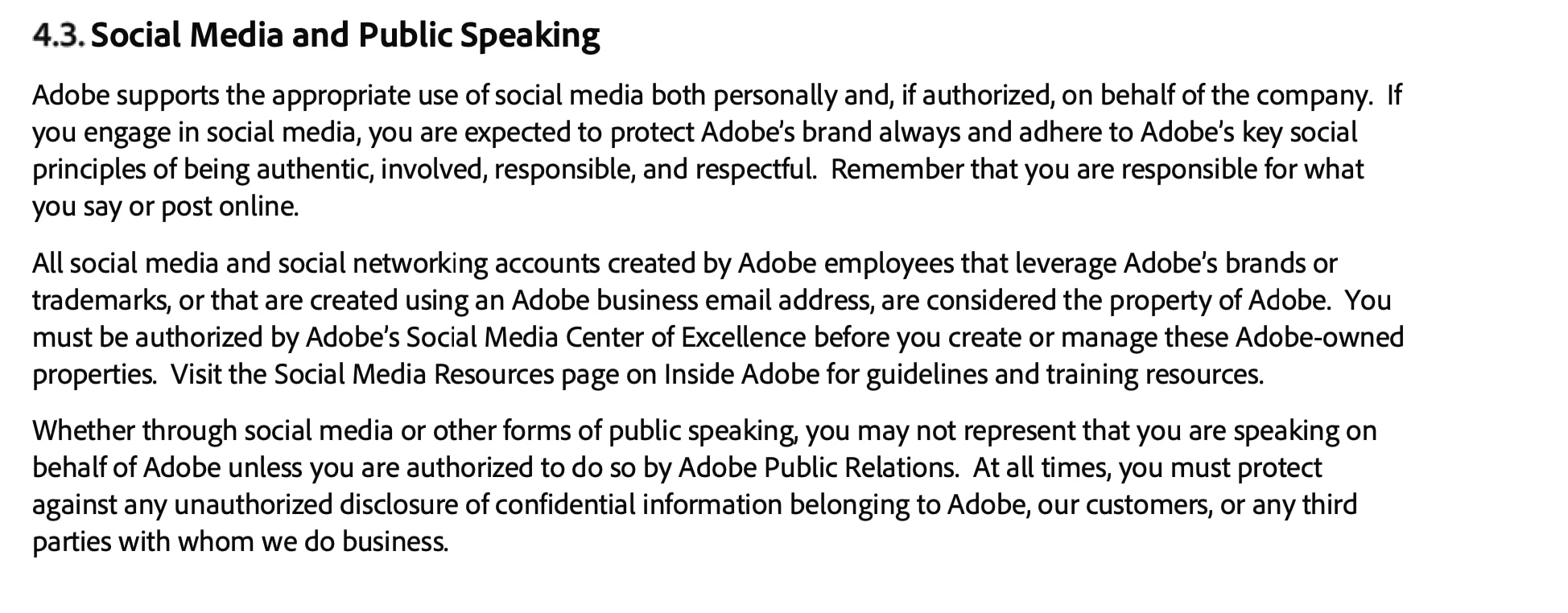
Adobe keeps their policy even more concise than Adidas. Adobe definitely has more in private, staff-only documents.
Good Points
- Clear clarity between official and unofficial postings on social media.
- Strongly emphasize what employees are allowed to do: “Adobe. You must be authorized by Adobe’s Social Media Center of Excellence before you create or manage these Adobe-owned properties.”
Not-so-good points.
- For a policy that repetitively differentiates between official and unofficial roles, it’s strange to see an absence of sample disclaimer language that staff can use.
- Adobe does not touch on how to address crises and conflicts.
- In general, there are incomplete specifics that should have been broken down into clear, more concrete bullets.
4. Dell Social Media Policy.
Dell perfectly exemplifies how a social media policy is just a small part of the social media world. Dell Social Media Policy’s strengths and weaknesses can be named as below.
Good Points
-
The policy acknowledges that Social Media is vast. One policy is not enough: “You are required to take this and other SMACU courses if you engage in social media as part of your role or otherwise discuss our products, industry, or competitors on social media, but we encourage all team members to take this training to learn more about social media best practices.”
-
Dell values intellectual property. “When you quote others, be sure to credit them and, if appropriate, add a link. You are also personally responsible for complying with any terms of the social media platform you are using”

- Dell specifies who are allowed to do what: “All team members are encouraged to speak about the company and share news and information, but only authorized, and trained spokespeople may speak on behalf of Dell Technologies and issue official company responses.”
Not-so-good points.
- Dell only provides suggestions on how to handle issues “If you encounter customer questions or issues on social media, contact social@dell.com for review and support.”
5. Ford Motor Company’s Digital Participation Guidelines.
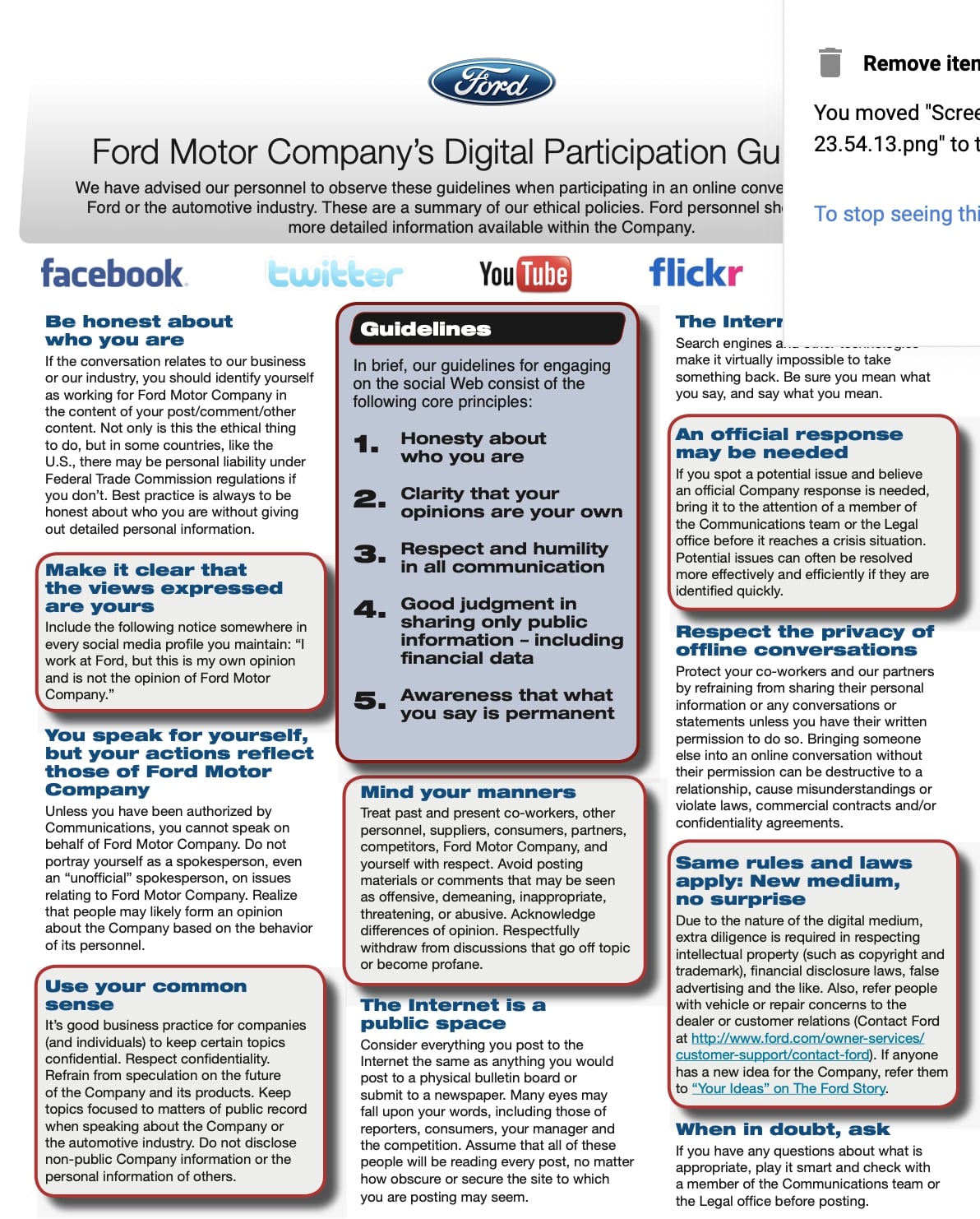
Another famous brand, another policy on social media for us to learn. Ford gets the writing job well done. We like the simplicity and clear structure of this policy.
Good points.
-
The policy is simple, following a one-page layout. Different blocks are dedicated to different rules. Straightforward, highlighted takeaways in each block. In other words, even if you only read the blue headers in bold font in each box, you will still get the picture of Ford’s policy.
-
Great way to put the challenges of social media: “The Internet is a public space. Consider everything you post to the Internet the same as anything you would post to a physical bulletin board or submit to a newspaper.”
-
The first example in this policy highlights honesty about who you are: “*Include the following notice somewhere in every social media profile you maintain: “I work at Ford, but this is my own opinion and is not the opinion of Ford Motor Company. *”
-
We like the no-blame culture here: “Bringing someone else into an online conversation without their permission can be destructive to a relationship, cause misunderstandings or violate laws, commercial contracts and/or confidentiality agreements.”
Not-so-good points.
-
The policy we are looking at is probably an old copy of Ford’s social media policy, but it’s definitely still relevant. Still, it could use a redesign, from the social media symbols at the top to the formatting.
-
There’s a missed opportunity to have staff interested in pushing for the company online, as with any other policies. We would like to see language such as “We promote your social media involvement and embrace your Ford Motor Company support! Your distinctive and trusted voice, as a Ford employee, helps to create the Ford brand.”
6. Intel Social Media Guidelines.
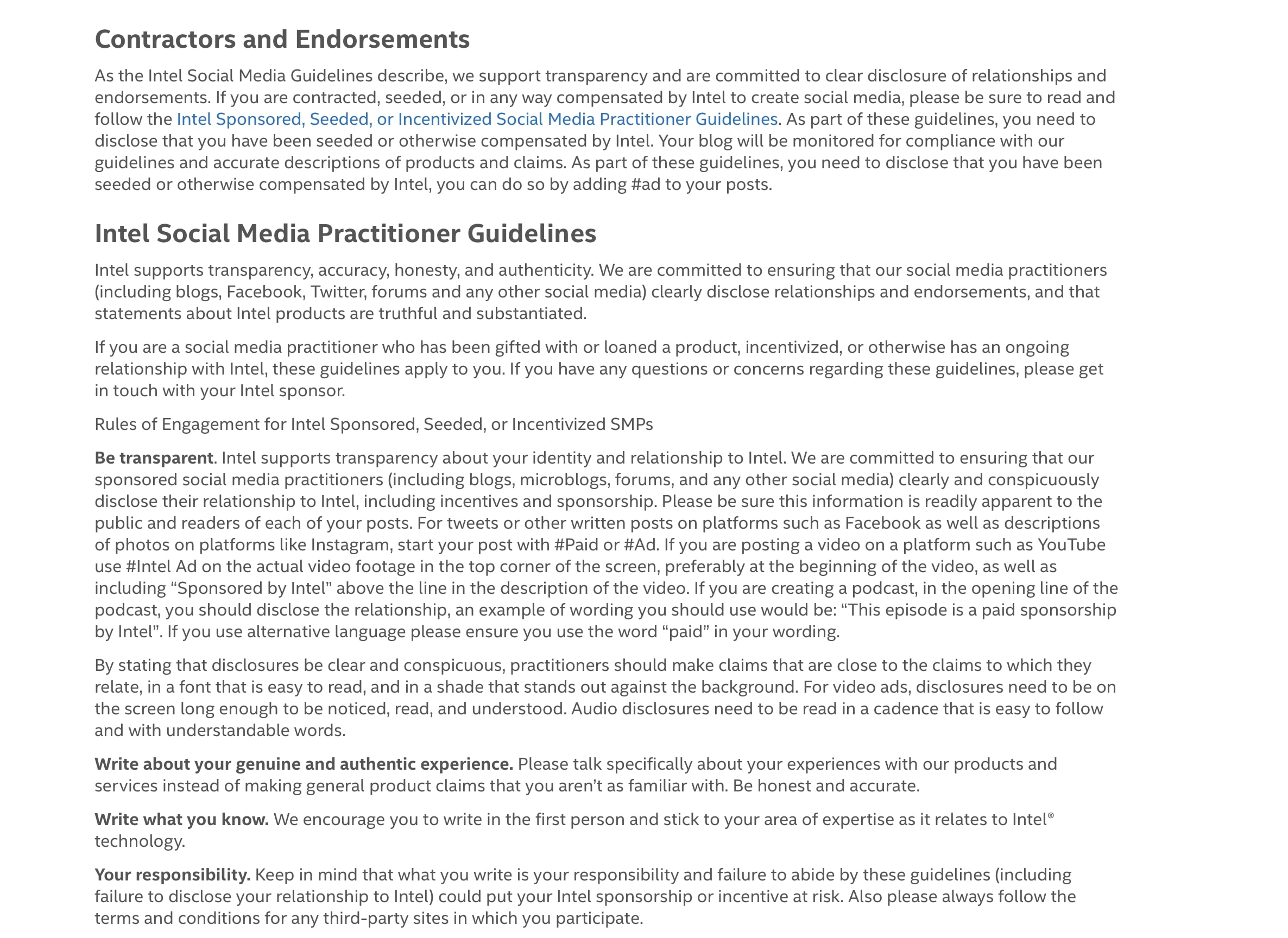
The social media policy of Intel is a bit hit or miss. Some wonderful pieces are there, and some excellent simplicity. Yet, several areas sound like the paper has been in possession of an attorney team for too long.
Good points.
-
Greatly simplified graphic of the rules of engagement staffs should know
-
Intel does not hesitate to show faith in its employees. “What do our policies mean? They mean that we trust you.”
-
Intel does not use many formal languages. Informal one can help to make your social media policy stay in your staffs’ minds: “Did you mess up? It happens. If you make a mistake, admit it immediately. Apologize if you need to. Be upfront, and correct the error as soon as possible.”
Not-so-good points.
The social media policy is, sadly, riddled with talk of the disclosure. Almost 50% of the policy is committed to exposing one’s partnership with Intel (often in the context of a paid sponsorship). While the subject of disclosure is needed in every social media policy, there’s just so much of it here that it may be wiser to elucidate on it in a separate document.
7. Walmart Social Media Guidelines.

Walmart’s social media policy is…one-of-a-kind, but not in a positive way
It’s unusual that it does not distinguish between employees and supervisors at multiple points in the policy. In addition, the wording of the strategy seems to place some distance between associates and Walmart itself.
That’s a controversial call, considering Walmart has over 2 million staff worldwide who can help push Walmart’s online coverage.
It just might be the world’s most enormous wasted chance in the history of corporate social media and employee engagement.
Good points.
- There is clear guidance on how to respond to criticism online: “Remember that we have a dedicated team tasked with responding to customer inquiries or criticism. Our official Walmart social team is responsible for engaging customers through our page. To avoid confusion, we ask that you not attempt to respond to customer inquiries or comments directed specifically to the company or asking for an official Company response on this site.”
Not-so-good points.
- Who the target audience is for this policy is very uncertain? It could be for anyone, visitors, staff, stakeholders. And why would customers want to look up Walmart’s policy on social media? Walmart’s policy has a general sense of uncertainty from the beginning.
For example: “We are happy to help our customers and associates through Twitter and look forward to hearing from you”. So, who are “we”? If “we” refer to “Walmart’s members,” then aren’t “associates” a part of the members?
-
As far as we are concerned, it’s not usual to see labor relations included in a social media policy. Walmart, with its storied record of anti-union efforts and controversial working conditions, does seem to use their social media policy as an effort to divert criticisms from external, open forums like social media to internal, encrypted channels they govern: “Consider using company established channels for job-specific issues.”
-
The policy does not openly encourage Walmart’s employees to advocate the brand on social media. That’s a lost opportunity with Walmart, as they have million-strong workers.
8. Pfizer Social Media Policy.
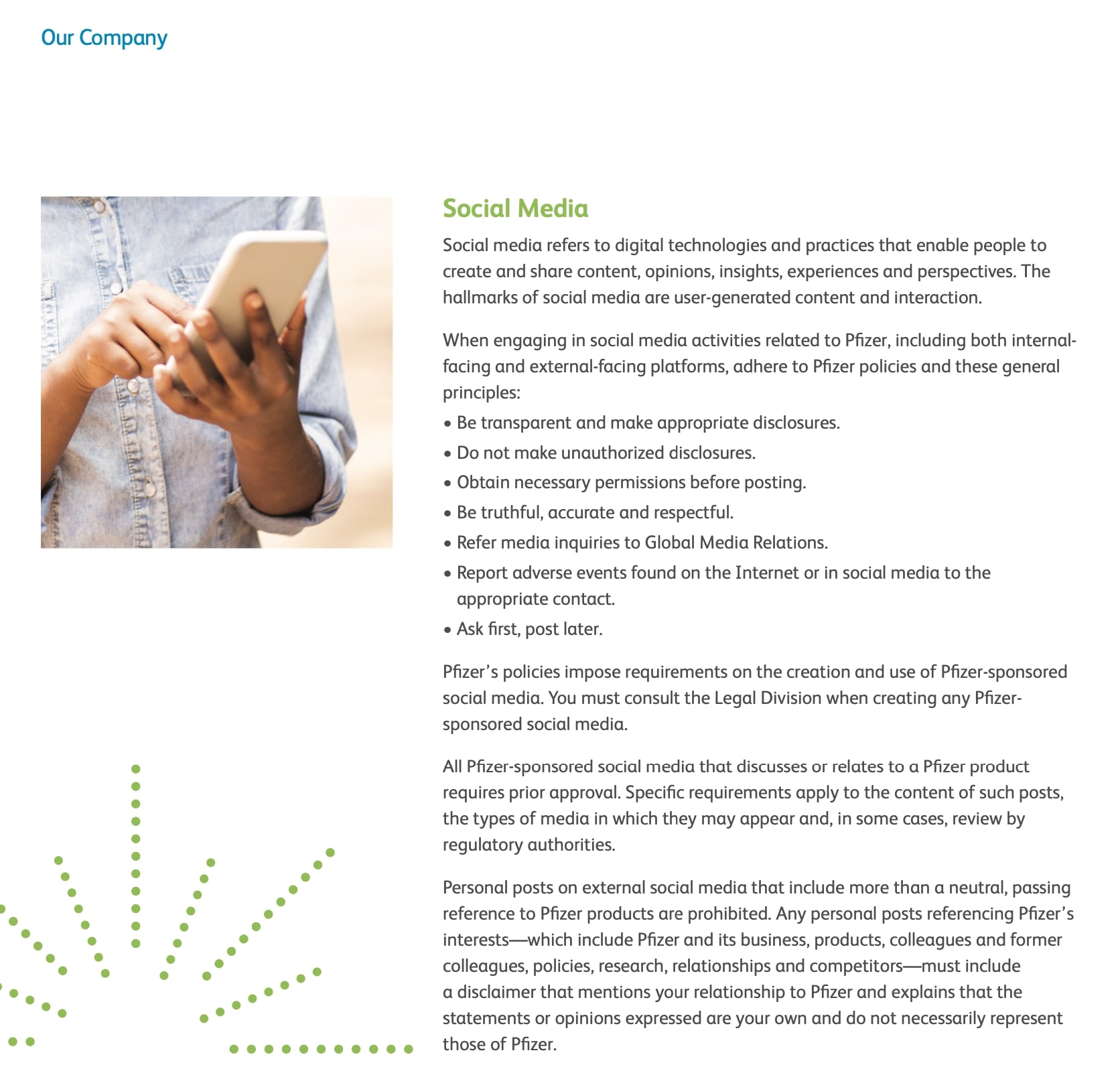
Pharmaceutical company Pfizer has everything we’d expect from a conservative, corporate social media policy. We get that, considering the business they’re in.
Will it contain the basics? Yes, they do
Will it get many workers willing to discuss in some meaningful way about Pfizer? Not really.
Good points
The way Pfizer speaks upfront about UGC sounds a little uncomfortable and monotone. “Social media refers to digital technologies and practices that enable people to create and share content, opinions, insights, experiences, and perspectives. The hallmarks of social media are user-generated content and interaction.”. However, this is not something we often see in a policy, so let’s call it a good point.
Not-so-good points.
-
There is not much warmth or humor in this strategy on social media. It looks like this paper was written by a legal team from start to finish. For example, it would be shocking to find a social media specialist who, in this day and age, would put the following in their policy “passing reference to Pfizer products are prohibited.” We assume brand advocacy is discouraged.
-
There are so many uncertainties. For example, Pfizer requires its employees to “ask first, post later, *” “Report adverse events found on the Internet or in social media to the appropriate contact.*” Still, there is no contact info or no reference to the department to contact.
Final Thoughts.
You have an overview of the fundamentals that go into a social media policy. You also have a template to get you started and the ability to break down the positives and negatives of every social media policy out there now!
We are optimistic that you have all the information you need to build from scratch a new social media policy that can get the work completed, strengthen an existing policy, or edit a template.
That is a policy that will protect your brand, inspire your staff to engage in social media, and accelerate market success.
New Posts






